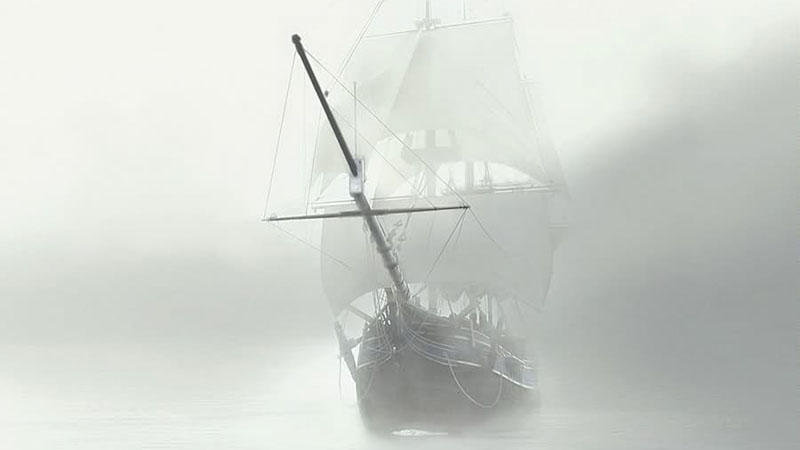
Jessup, Allen, and the “Mary Celeste”
by David J. Halperin
Journal of a UFO Investigator
November 30, 2011

On December 4, 1872, the American ship Mary Celeste was found abandoned and drifting in the Atlantic Ocean. Its crew had vanished, never to be seen or heard from again. The mystery inspired, in the nineteenth century, a flesh-creeping story by Sir Arthur Conan Doyle entitled “J. Habakkuk Jephson’s Statement.” In the twentieth century, it led off the chapter on “Disappearing Ships and Crews” in M. K. Jessup’s The Case for the UFO (published 1955).
Of course Jessup thought the Mary Celeste had been raided by a UFO. “To attempt to postulate motive for space inhabitants kidnapping crews from ships—not to mention isolated individuals to which we shall come momentarily—is in the realm of pure speculation,” Jessup wrote—as if some UFO having carried out the abduction were, by contrast, a matter of established fact! “On the other hand … our space friends would want to know
what has happened to us since they left, or what has happened to us since they put down here. Again, there is always the possibility that the open seas provide an easy catching place.”
I’ve never studied the Mary Celeste mystery. All I know about it comes from reading Jessup’s book and Wikipedia. I have no opinion on what happened to the vanished sailors. What interests me is what Jessup did with the story, and still more what Carl Allen did with it when he sat down to annotate the paperback edition of The Case for the UFO. For, as I’ve described in an earlier post, there’s not the smallest doubt that it was Allen, and Allen alone, who penned the marginal notes supposedly authored by the “three gypsies.”
In the annotated edition, mailed in 1955 or 1956 to the Office of Naval Research in Washington, the words “the open seas provide an easy catching place” are underlined in the ink color associated with “Mr. B.” And “Mr. B” comments in the margin: “Ought to, the Sea is Natural Home of the Little bastards.”
Also from “Mr. B,” the following note: “The Little pricks come-aboard at nite and go Wandering about the Decks, Scares the Crews but No Crew Man meeting one, ever says so, Just quits drinking.”
Carl Allen’s naval background—he was the guy, remember, who supposedly witnessed the ship being made invisible in the Philadelphia Navy Yard in 1943—comes to the fore here. But in an exceedingly bizarre manner.
Given Allen’s interest in disappearing/invisible ships, it’s worth glancing through his whole string of comments on the Mary Celeste. At the very beginning of the chapter, when Jessup speaks of seaborne disappearances as “having occurred,” Allen comments in the person of “Mr. A”: “Yes, Many, Many times. More often than is recorded. Ulyses [sic] & crew believed suffered same fate. Nes [? maybe “his”?] Wanderings thus Were Pure Invention.”
And modern myth and classic myth thus join hands.
“I found the log book in the mate’s cabin, on his desk,” one of the men who boarded the deserted ship is quoted in Jessup’s book as saying. And “Mr. A” writes: “CAPT. ALWAYS TAKES THE LOG WHEN ABANDONING SHIP. LOG MUST BE TAKEN EVEN IF CAPT. IS DEAD. THEY WERE FROZE AND ‘SWIPED’ ”
The same witness adds: “I noticed the impression in the Captain’s bed as of a child having lain there.” This provokes the following dialogue among the “three gypsies”—who, of course, are one and the same Carl Allen:
“Mr. B”: “NOT A CHILD, WAS ANOTHER ‘LITTLE-MAN’ OF MU.”
“Mr. A”: “GRAVITY IS GREAT STRAIN ON THEM, THEY TIRE EASILY & MUST REST OFTEN WHEN ON ‘TERRA’ ”
“Jemi”: “EXCEPT UNDERSEAS”
A few pages later, “Mr. A” writes: “Alcohol fumes partly inebriated the Whole Crew & L-Ms WERE OVERHEAD; Drunk men naturally are not Mentally Paralyzed by ‘Freeze’ They seized Lines as they were starting to ascend & Hung on Grimly. Some fell on Deck, L-M SHIP STOPPED M-C & took them all off.”
The “L-Ms” are “Little Men,” presumably those same “little bastards” and “little pricks” of which “Mr. B” speaks with such disgusted assurance.
Well, reader: this is what you find as you page through the famous “Varo edition” of The Case for the UFO, with all of Allen’s marginal scribblings meticulously reproduced. You will sympathize, no doubt, with the letter writer quoted in my last post, who twice sat up all night reading the Varo text and “regarded it as totally absurd and probably the work of a schizophrenic.” (Understanding, no doubt, “schizophrenic” in its literal sense of “split personality.”) That Carl Allen was not quite sane in the way you and I regard sanity, is almost a foregone conclusion. We’ll see it confirmed again and again, as we follow this bizarre figure through the lives of those he touched.
Yet that same letter writer, his name unfortunately lost, seems to have recognized something strange and profound in all the madness. (“I realized that whoever made the annotations knew a great deal about the UFO phenomenon—far more than was known to the general UFO field in 1956 when the book first appeared!”) Talk of the “freeze” or the “deep freeze” recurs in Carl Allen’s January 1956 letter to Jessup, describing the experiment of the invisible ship. What Allen imagined happening on board the Mary Celeste in 1872, and what he remembered having seen in the Philadelphia Navy Yard in 1943, must have bubbled up from the same region of his unquestionably disturbed—yet magnificently creative—unconscious.
Rippling from there to the awareness of M. K. Jessup … of Gray Barker … of the wider culture. Which knows The Philadelphia Experiment as the title of a bestselling paperback, and a grade-B movie.
Reprinted With Kind Permission from This Original Article

Author David J. Halperin can be reached directly by email at david@davidhalperin.net, or on Facebook.
